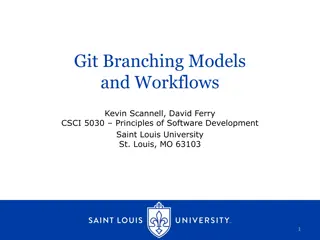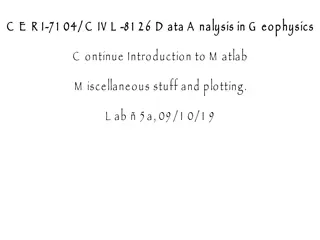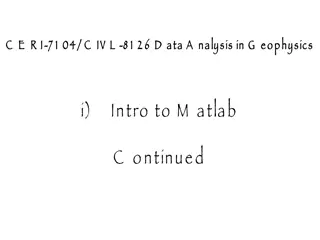Understanding Geophysics: Methods, Branches, and Applications
Geophysics applies physics principles to study Earth's physical processes and properties, contributing to scientific and economic advancements. The field encompasses various branches such as Solid Earth Geophysics and Exploration Geophysics, with scopes including natural hazard studies and resource explorations. Geophysical methods like Gravity Method play a key role in non-destructive geophysical techniques for Earth investigation.
Download Presentation

Please find below an Image/Link to download the presentation.
The content on the website is provided AS IS for your information and personal use only. It may not be sold, licensed, or shared on other websites without obtaining consent from the author. Download presentation by click this link. If you encounter any issues during the download, it is possible that the publisher has removed the file from their server.
E N D
Presentation Transcript
Geophysics (Definition) Geophysics is the application of method of physics to the study of the Earth. On the other sense, it is a subject of natural science concern with the physical processes and the physical properties of the earth and it s surrounding space environment and the use of co-ordinary methods for the analysis. It involves the application of physical theories and measurements to discover the properties and processes of the earth.
Geophysics Geophysics has contributed significantly in the understanding of many physical processes that lead to scientific and economic contribution to our society.
Branches of Geophysics Solid Earth Geophysics : Earthquakes,Tsunamis, Tectonics Geodynamics Environmental & Engineering Geophysics : Groundwater exploration Contaminant delineation Utility or objectdetection Exploration Geophysics : Oil and Gas exploration Minerals exploration
Scopes of Geophysics Natural hazard studies: Earthquake Landslide Resource explorations: Oil and gas exploration Mineral prospecting Geothermal exploration Groundwater exploration
Scopes of Geophysics(Cont.) Engineering: Underground utilitylocating Concrete inspection Rebar locating Pavement evaluation Underground void locating Ground strength testing Environmental application: Underground storagetank locating Contamination delineation Landfill delineation Bedrock depth mapping
Geophysical Methods Potential Fields: Gravity Magnetics Wave Propagation: Seismic (SoundWaves) Radar (EM Waves) Diffusive Fields: Electrical Heat Flow Electromagnetics(EM)
Geophysical methods Gravity method: Gravity method is a non-destructive geophysical technique that measures differences in the earth s gravitational field at specific locations. The gravity method is a relatively cheap, non- invasive, non-destructive remote sensing method.
Gravity method In gravity surveying, subsurface geology is investigated on the basis of variations in the Earth s gravitational field arising from differences of density between subsurface rocks. An underlying concept is the idea of a causative body, which is a rock unit of different density from its surroundings.
Application of Gravity method Determine shape of the Earth Hydrocarbon exploration Regional geological studies Iso-static compensation determination Detection of sub-surface cavities (microgravity) Location of buried rock-valleys Determination of glacier thickness Tidal oscillations Basin Geometry
The gravitational constant (also known as the "universal gravitational constant", the "Newtonian constant of gravitation", or the "Cavendish gravitational constant"), denoted by the letter G, is an empirical physical constant involved in the calculation of gravitational effects in Sir Isaac Newton's law of universal gravitation and in Albert Einstein's. the measured value of the constant is known with some certainty to four significant digits. its value is approximately G=6.674 10 11dyn or 6.674 10 8 nt
gravitational acceleration in physics, gravitational acceleration is the acceleration on an object caused by the force of gravitation. Neglecting friction such as air resistance, all small bodies accelerate in a gravitational field at the same rate relative to the center of mass. This equality is true regardless of the masses or compositions of the bodies. Newton's law of universal gravitation states that there is a gravitational force between any two masses that is equal in magnitude for each mass, and is aligned to draw the two masses toward each other. The formula is:
Gravity method The basis on which the gravity method depends is encapsulated in two laws derived by Newton, namely his Universal Law of gravitation and his Second Law of Motion. F = GMm............(1) F = mg ........(2) R2 g =GM..........(3) R2 This shows that the magnitude of acceleration due to gravity on Earth (g) is directly proportional to the mass (M) of the Earth and inversely proportional to the square of the Earth s radius (R)
Gravity method Units of gravity 1 Gal = 1 cm / sec2 1 Gal = 1000 mGal 1 mGal = 10-3Gal = 10-3cm s-2
Calculating Gravity Anomalies of Simple Bodies Gravity anomaly of a body can be calculated by summing contribution of its component elements using computer. For simple bodies, anomaly can be calculated simply: Sphere or Point Mass
Gravity method ( Process ) Gravity techniques measure minute variations in the earth's gravity field. Based on these variations, subsurface density and thereby composition can be inferred. These variations can be determined by measuring the earth's gravity field at numerous stations along a traverse, and correcting the gravity data for elevation, tidal effects, topography, latitude, and instrument drift.
Gravity method ( Process ) The gravity field on the surface of the Earth is not uniformly the same everywhere. It varies with the distribution of the mass materials below. AGravity survey is an direct means of calculating the density property of subsurface materials. The higher the gravity values, the denser the rock beneath.
Gravity method (Equipment) Modern instruments capable of rapid gravity measurements are known as gravity meters or gravimeters. Gravimeters are basically spring balances carrying a constant mass. Variations in the weight of the mass caused by variations in gravity cause the length of the spring to vary and give a measure of the change in gravity.
Gravity method (Equipment) There are two types of gravimeters: 1. Relative and 2. Absolute. Absolute gravimeters measure the local gravityin absolute units, gals. Relative gravimeters compare the value of gravity at one point with another. They must be calibrated at a location where the gravity is known accurately, and then transported to the location where the gravity isto be measured. They measure the ratio of the gravity at the two points.
Gravity reduction Elevation corrections Correction for the differing elevations of gravity stations is made in three parts : Free air Correction Terrain Correction
Latitude Correction Gravity varies with latitude because of the non-spherical shape of the Earth and because the angular velocity of a point on the Earth s surface decreases from a maximum at the equator to zero at the poles. The centripetal acceleration generated by this rotation has a negative radial component that consequently causes gravity to decrease from pole to equator. Consequently, points near the equator are farther from the centre of mass of the Earth than those near the poles, causing gravity to increase from the equator to the poles.
Tidal Correction Gravity measured at a fixed location varies with time because of periodic variation in the gravitational effects of the Sun and Moon associated with their orbital motions, and correction must be made for this variation in a high precision survey. In spite of its much smaller mass, the gravitational attraction of the Moon is larger than that of the Sun because of its proximity.
Tidal Correction These solid Earth tides are considerably smaller than oceanic tides and lag farther behind the lunar motion. They cause the elevation of an observation point to be altered by a few centimeters and thus vary its distance from the centre of mass of the Earth. The periodic gravity variations caused by the combined effects of Sun and Moon are known as tidal variations. They have a maximum amplitude of some 3 gu and a minimumperiod of about 12 h.
Isostacy corrections Uses for regional survey not for local regions, due it need a huge area to cover the effect of mass by gravity























